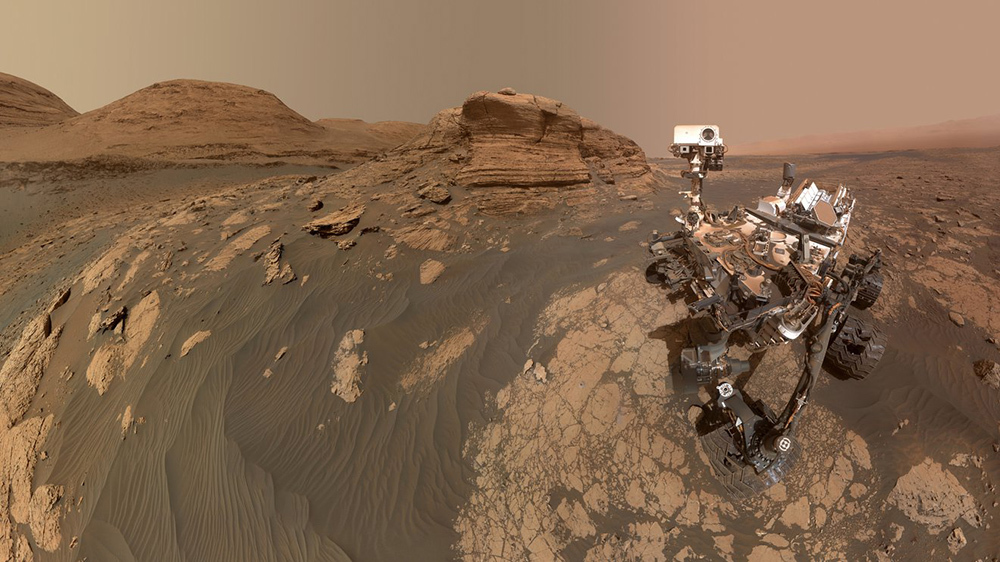9.09.2024
The Curiosity rover has been roaming the red planet for 12 years

The ChemCam instrument on the Curiosity rover has fired 1 million times since it landed on Mars in 2012. Image credit: NASA/JPL-Caltech/MSSS
The ChemCam instrument, developed at Los Alamos National Laboratory, recently zapped its laser for the 1 millionth time on Mars. Sitting on top of NASA’s Curiosity rover, ChemCam has been helping make groundbreaking discoveries since 2012.
“Not only is this a remarkable technical accomplishment for our instrument, but it also represents a staggering amount of chemistry data from the surface of Mars,” said Nina Lanza, principal investigator of ChemCam. “Each laser pulse produces a single complex spectrum that individually provides a wealth of geochemistry information. And we have 1 million of those — and counting!”
ChemCam uses a technique called laser-induced breakdown spectroscopy to zap rocks to create a plasma, and then collects the light from that plasma to understand what elements are present on the planet’s surface. Its goal is to establish past habitability on Mars, addressing the question of if Mars was once suitable for life.
"Our greatest strength lies in the international, technical and scientific collaboration around this project. Bringing this new method of analysis to Mars has opened up a new field of study, which consists of studying rocks at the grain scale,” said Olivier Gasnault, research fellow at the National Centre for Scientific Research (CNRS) and the Institut de Recherche en Astrophysique et Planétologie (IRAP), and co-leader of ChemCam.
A wealth of scientific data
Over the years, the instrument has played an important role in NASA’s mission and made a number of significant discoveries. Some of these findings include the discovery of manganese oxides on Mars in 2016, which indicate that higher levels of atmospheric oxygen could have once existed there. This hint of more oxygen in Mars’ early atmosphere added to other Curiosity findings — such as evidence of ancient lakes — that reveal how Earth-like Mars may have once been.
In 2017, ChemCam made the first detection of the element boron in salts in Gale crater. Boron has a unique role in prebiotic chemistry by supporting the formation of RNA.
In 2019, ChemCam found that the surface of Mars was once home to shallow, salty ponds that went through episodes of overflow and drying. An analysis of rocks enriched in mineral salts in Gale Crater showed that the climate on Mars was not as stable as once thought; there were very wet periods and very dry periods.
“We have found that Mars is much more chemically diverse than we expect, especially in rocks that are directly tied to water alteration, thanks to ChemCam,” said Patrick Gasda, a research scientist at Los Alamos and member of the ChemCam team.
ChemCam also helped provide the first analysis of the Glen Torridon region of the Gale Crater, finding that bedrock in the area was changed by groundwater in the planet’s early history.
And earlier this year, Curiosity discovered elemental sulfur, which marks the first time this mineral has ever been found in a pure form on Mars.
Curiosity’s primary mission was supposed to last about two years. More than 12 years later, the rover is still going, exploring new areas on Mars and collecting data along the way. ChemCam will continue to support the mission for as long as the rover lasts.
“We have learned so much from our 1 million spectra already, and I have no doubt that we will continue learning new things about Mars from these and future spectra for many years to come,” Lanza said.
A collaborative effort between the U.S. and France
The ChemCam project is jointly run by Los Alamos and IRAP. The team represents a remarkable and enduring collaboration between the U.S. and France over 20 years. More than 70 researchers and engineers work as a single team distributed across more than 20 institutions worldwide. Together with the Jet Propulsion Laboratory in California, the team supports the operation of the ChemCam instrument on Mars and the scientific interpretation of the data it returns.
Quelle: Los Alamos National Laboratory
